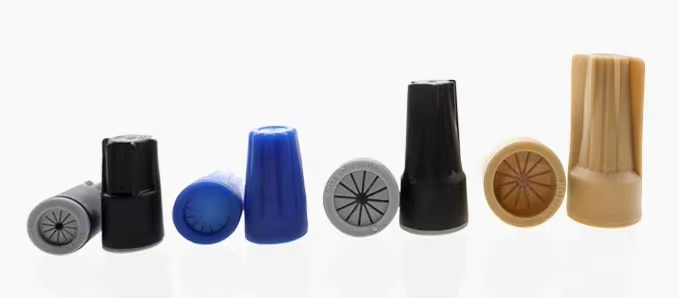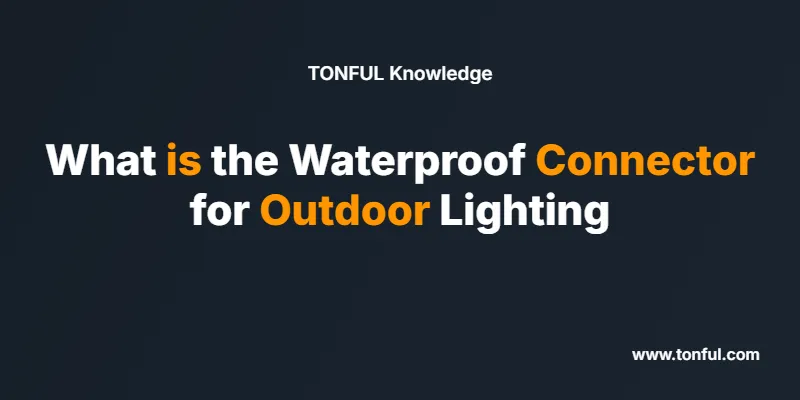A waterproof connector for outdoor lighting is a specialized electrical component designed to create secure, weather-resistant connections between outdoor light fixtures and electrical wiring systems. These connectors protect electrical connections from moisture, dirt, and environmental damage while maintaining reliable power transmission in all weather conditions.
Waterproof connectors are essential for any outdoor lighting installation, from residential landscape lighting to commercial security systems. They prevent dangerous electrical shorts, reduce fire risks, and ensure your outdoor lighting system operates safely and reliably for years.
What Are Waterproof Connectors? Key Definitions and Types
Basic Definition
Waterproof connectors are electrical joining devices that create sealed connections resistant to water, moisture, and environmental contaminants. They feature specialized sealing mechanisms like rubber gaskets, silicone seals, or compression fittings that prevent water ingress while maintaining electrical conductivity.
Primary Types of Waterproof Connectors
Wire Nuts with Silicone Coating

- Traditional wire nuts enhanced with waterproof silicone gel
- Rated for direct burial and wet locations
- Most common for residential applications
Heat Shrink Connectors

- Feature heat-activated adhesive lining
- Create completely sealed connections when heated
- Ideal for permanent installations
Compression Connectors
- Use mechanical pressure to create watertight seals
- Quick installation without tools
- Popular for landscape lighting systems
Threaded Cable Glands
- Provide cable entry sealing for junction boxes
- Feature multiple sealing rings
- Professional-grade solution for complex installations
Key Differences: Waterproof vs Regular Electrical Connectors
| Feature | Regular Connectors | Waterproof Connectors |
|---|---|---|
| Moisture Protection | None – indoor use only | IP65-IP68 rated sealing |
| Installation Location | Dry indoor environments | Outdoor, underground, wet areas |
| Lifespan Outdoors | Fail within months | 15-25+ years |
| Safety Compliance | Basic electrical codes | NEC Article 410 outdoor requirements |
| Cost | $0.10-$0.50 each | $1.00-$15.00 each |
| Temperature Range | Limited | -40°F to 221°F typical |
⚠️ Safety Warning: Never use regular electrical connectors outdoors. They create serious fire and electrocution hazards when exposed to moisture.
IP Rating System: Understanding Waterproof Protection Levels
| IP Rating | Water Protection Level | Outdoor Lighting Applications |
|---|---|---|
| IP44 | Splash resistant | Covered patios, eaves |
| IP65 | Water jet resistant | Most outdoor fixtures |
| IP67 | Temporary submersion | Ground-level installations |
| IP68 | Continuous submersion | Underwater, pond lighting |
Expert Tip: For standard outdoor lighting, choose IP65 or higher rated connectors. Underground installations require IP67 minimum.
Applications and Use Cases for Waterproof Connectors
Residential Applications
- Landscape lighting systems – Path lights, accent lighting
- Security lighting – Motion sensors, floodlights
- Decorative lighting – String lights, garden features
- Pool and spa lighting – Underwater and perimeter fixtures
Commercial Applications
- Parking lot lighting – Pole-mounted fixtures
- Building facade illumination – Architectural lighting
- Signage lighting – Backlit signs, channel letters
- Sports facility lighting – Stadium, court lighting
Specialized Environments
- Marine applications – Dock, boat lighting
- Industrial facilities – Hazardous location lighting
- Agricultural settings – Barn, greenhouse lighting
How to Choose the Right Waterproof Connector: Selection Criteria
1. Assess Your Installation Environment
Above Ground Installations
- Choose IP65 rated connectors minimum
- Consider UV-resistant materials
- Ensure temperature rating matches climate
Underground/Direct Burial
- Require IP67 or IP68 rating
- Select connectors rated for direct burial
- Use connectors with corrosion-resistant materials
2. Match Electrical Specifications
| Voltage Level | Recommended Connector Types |
|---|---|
| 12V Low Voltage | Compression, heat shrink |
| 120V Line Voltage | Wire nuts with gel, cable glands |
| 240V High Voltage | Professional-grade threaded connectors |
3. Consider Wire Gauge Compatibility
Common Wire Gauges for Outdoor Lighting:
- 18 AWG – Low voltage landscape lighting
- 14 AWG – 15-amp circuits, shorter runs
- 12 AWG – 20-amp circuits, longer runs
- 10 AWG – High-power applications
Expert Tip: Always check connector wire gauge range before purchase. Oversized connectors may not seal properly on smaller wires.
Step-by-Step Installation Process
For Heat Shrink Waterproof Connectors:
- Strip wire ends to manufacturer specifications (typically 1/4 inch)
- Slide heat shrink over one wire before making connection
- Join wires using appropriate splice method
- Center heat shrink over connection point
- Apply heat using heat gun or lighter (not flame directly on connector)
- Allow cooling for complete adhesive bond
- Test connection before final installation
For Wire Nuts with Silicone Gel:
- Strip wires to appropriate length
- Twist wires together clockwise
- Thread wire nut over connection clockwise
- Verify secure connection with gentle pull test
- Apply silicone coating if not pre-filled
- Install in weatherproof junction box
⚠️ Safety Warning: Always turn off power at breaker before making any electrical connections. Use a voltage tester to verify power is off.
Code Compliance and Safety Requirements
National Electrical Code (NEC) Requirements
Article 410 – Luminaires and Lighting Equipment
- All outdoor connections must be in weatherproof enclosures
- GFCI protection required for outdoor circuits
- Proper grounding essential for safety
Article 300 – Wiring Methods
- Underground wiring depth requirements
- Approved connector types for wet locations
- Cable protection and support specifications
Professional Installation Recommendations
When to Call an Electrician:
- Line voltage (120V/240V) installations
- Complex control systems
- Code permit requirements in your area
- Underground electrical work
Troubleshooting Common Problems
Problem: Connector Failure in Wet Conditions
Symptoms: Flickering lights, intermittent operation, blown fuses
Solutions:
- Verify IP rating meets environment needs
- Check for damaged sealing gaskets
- Ensure proper installation technique used
Problem: Corrosion on Connector Contacts
Symptoms: Dim lighting, high resistance connections, heat buildup
Solutions:
- Use dielectric grease on connections
- Upgrade to marine-grade connectors
- Ensure proper drainage around connections
Problem: Physical Damage to Connectors
Symptoms: Visible cracks, loose connections, water intrusion
Solutions:
- Protect connections with rigid conduit
- Use strain reliefs on cable entries
- Regular inspection and maintenance schedule
Product Selection Guide: Top Connector Types by Application
Best for Low Voltage Landscape Lighting
Recommended: Compression-style waterproof connectors
- Quick installation without tools
- Excellent moisture sealing
- Suitable for 12V systems
Best for Line Voltage Outdoor Fixtures
Recommended: Wire nuts with silicone gel in weatherproof boxes
- Code-compliant installation
- Proven reliability record
- Professional contractor preferred
Best for Underground/Direct Burial
Recommended: Heat shrink connectors with adhesive lining
- Permanent waterproof seal
- Suitable for direct soil contact
- Long-term reliability
Expert Tips for Maximum Reliability
💡 Pro Tip: Always use dielectric grease on connector threads and contact surfaces to prevent corrosion and ensure easy future maintenance.
💡 Pro Tip: Install connections with a slight downward angle to promote water drainage away from the connection point.
💡 Pro Tip: Keep spare connectors on hand that match your system specifications. Outdoor connectors can fail unexpectedly during severe weather.
Cost Considerations and Value Analysis
Budget vs. Premium Connector Options
| Connector Type | Price Range | Expected Lifespan | Best Use Case |
|---|---|---|---|
| Basic Wire Nuts + Gel | $1-3 each | 5-10 years | Temporary installations |
| Heat Shrink Connectors | $2-5 each | 15-20 years | Permanent residential |
| Professional Cable Glands | $5-15 each | 20-25 years | Commercial applications |
Investment Analysis: Premium waterproof connectors cost 3-5x more upfront but last 2-3x longer with superior reliability, making them more cost-effective long-term.
Frequently Asked Questions
What IP rating do I need for outdoor lighting connectors?
For most outdoor lighting applications, choose IP65 or higher. Underground installations require IP67 minimum. Submersible applications need IP68 rated connectors.
Can I use regular wire nuts outdoors if I put them in a weatherproof box?
No. Regular wire nuts will eventually corrode and fail even in weatherproof enclosures. Always use connectors specifically rated for wet locations.
How often should I inspect outdoor lighting connections?
Inspect connections annually, preferably before severe weather seasons. Look for signs of corrosion, physical damage, or water intrusion.
What’s the difference between waterproof and water-resistant connectors?
Waterproof connectors provide complete protection against water ingress (IP67-IP68). Water-resistant connectors offer limited protection against splashing (IP44-IP54) but may fail if submerged.
Do waterproof connectors require special tools for installation?
Heat shrink connectors require a heat gun. Compression connectors install by hand. Wire nuts need basic electrical tools. Cable glands may require wrenches for proper sealing.
Can waterproof connectors handle temperature extremes?
Quality waterproof connectors are rated from -40°F to 221°F. Always verify temperature ratings match your local climate conditions.
Are there different connectors for different wire types?
Yes. Solid wire, stranded wire, and different insulation types may require specific connector designs for proper sealing and electrical contact.
How do I know if my waterproof connector has failed?
Signs include flickering lights, intermittent operation, visible corrosion, moisture inside enclosures, or blown circuit protection devices.
Conclusion: Ensuring Safe, Reliable Outdoor Lighting Connections
Selecting the right waterproof connector for your outdoor lighting system is crucial for safety, reliability, and long-term performance. By understanding IP ratings, matching connectors to your specific application, and following proper installation procedures, you can create lighting connections that withstand harsh weather conditions for decades.
Key Takeaways:
- Always use connectors rated IP65 or higher for outdoor applications
- Match connector specifications to your wire gauge and voltage requirements
- Follow NEC code requirements for wet location installations
- Invest in quality connectors for long-term reliability and safety
Professional Recommendation: For complex outdoor lighting systems or line voltage installations, consult with a licensed electrician to ensure code compliance and optimal safety. The investment in professional installation pays dividends in system reliability and peace of mind.
Remember: Your outdoor lighting system is only as reliable as its weakest connection. Choose waterproof connectors that exceed your environment’s demands rather than just meeting minimum requirements.

